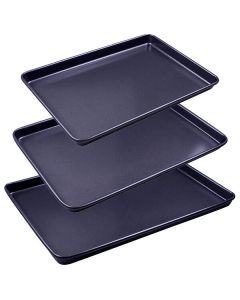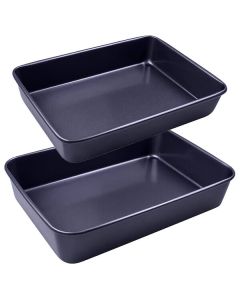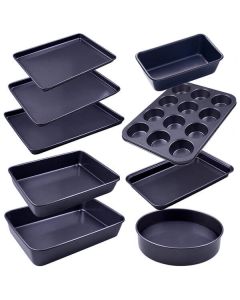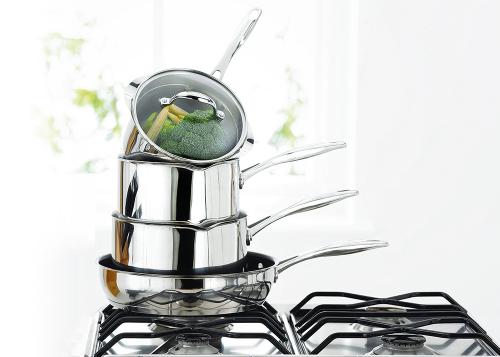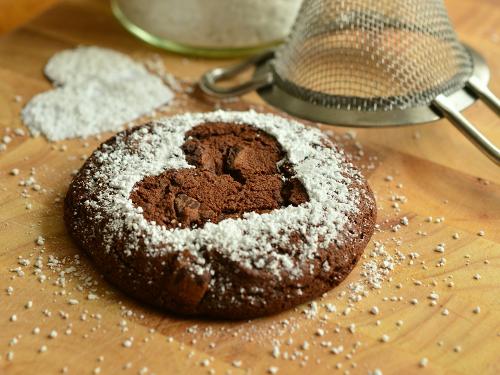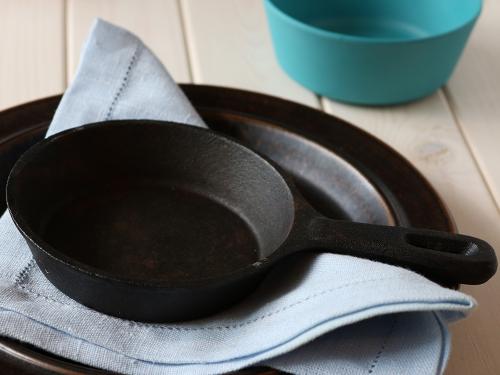Bakeware Buying Guide
Categories:
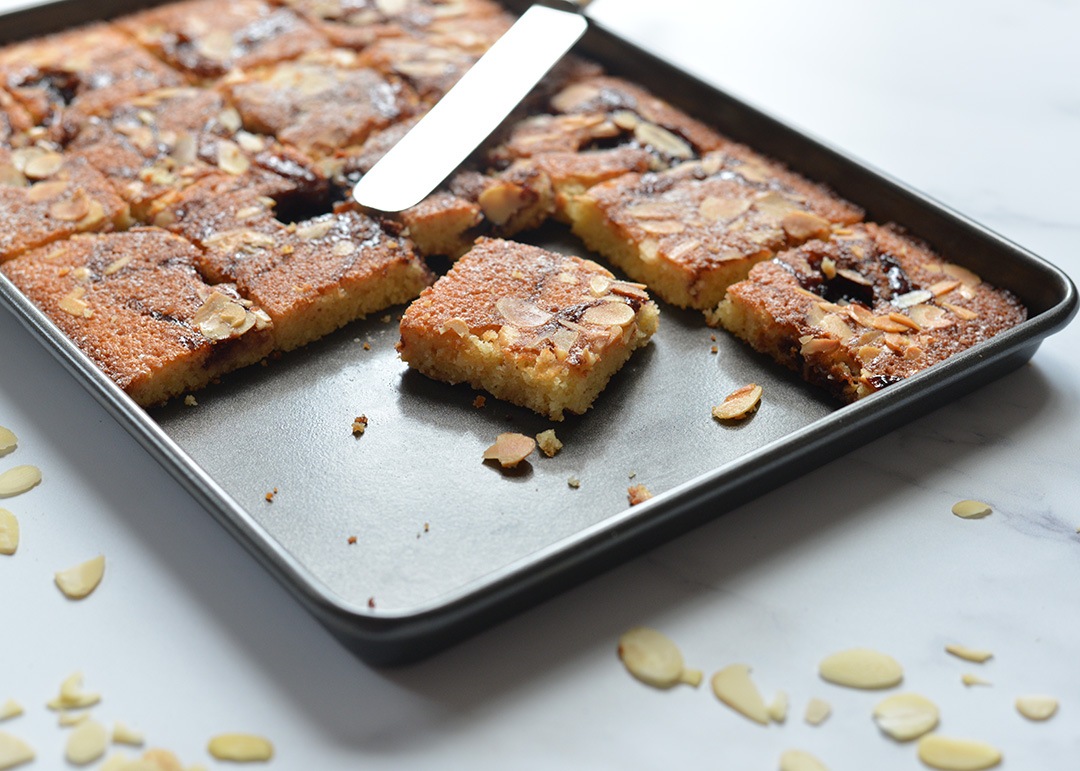
Baking has traditionally passed down from generation to generation within families; children learning from their parents at an early age the enjoyment and skills required to make cakes and cookies. Many of the old techniques and reliable old bakeware items have been in the family for years.
Nowadays though some bakeware items are designed to simplify some of the more difficult techniques and skills required to create masterpieces, and save time on time consuming tasks. These modern designs are quite innovative and require only a small investment for a bakeware item that suits your style and baking requirements. Hopefully here we can clearly define between the different bakeware items available today and explain the different methods used for each one.
Popular Non-Stick Bakeware Sets
Bakeware
Baking Dish Baking dishes come in a variety of sizes and are generally rectangular, square or circular. They often have shaped handles on the sides to aid lifting when wearing oven gloves. Baking dishes can be used for a variety of tasks including baking, roasting and even serving at the table. Lasagnes, pies (sweet and savoury) and gratins can all be made in a baking dish. Available in a variety of materials including cast iron, stoneware, hard anodised, carbon steel and glass.
Cake Tin A cake tin will normally be round in shape but they are also available as square, rectangular or novelty shapes. Some feature a loose base for easily removing the cake while others feature a ‘spring form’ collar around the tin which expands, allowing the cake to be released from the tin. Cake tin materials will vary from silver anodised, hard anodised to carbon steel and silicone and will mostly have non-stick coatings.
Loaf Tin Unlike the cake tin, the loaf tin is generally only rectangular in shape and sometimes feature handles or grips at each end. Loaf tin materials include silver anodised, hard anodised and carbon steel. These tins may also feature a non-stick coating to aid in the release of the bread from the tin. Traditionally loaves and breads are made in this type of tin, but they can also be used for terrines and cakes.
Pudding Basin A pudding basin is a deep, rounded bowl with a flat base for stability, sometimes including a lid. Pudding basins are generally used for steaming desserts such as Christmas pudding and steamed puddings. Many pudding bowls are made from stoneware, but can also be silver anodised, hard anodised and plastic and can be used safely in a pressure cooker. The plastic basins are also suitable for use in the microwave.
Yorkshire Pudding Tin A Yorkshire pudding tin is a shallow tin normally with four circular indents in which to cook the batter. These indents are larger in diameter than the ones found in a normal cake tin but much shallower. These tins will be non-stick so the batter can rise and be released easily from the tin. They are normally made from hard anodised or carbon steel to withstand the high temperatures needed to cook a successful Yorkshire Pudding.
Baking Sheet/Tray A baking tray is a very shallow tray with a thin base for oven baking and normally has a non-stick surface. Baking trays are commonly rectangular to fit the oven shelves, but some can be square. A baking sheet is similar to the baking tray but without the sides to ease the removal of baked goods, there may be a grip or small lip on one or two sides of the sheet to avoid it slipping out of your hand when removing from the oven. As with other bakeware, the materials used for trays and sheets include silver anodised, hard anodised and carbon steel.
Flan/Quiche Tin Flan and quiche tins are round, shallow tins for baking flans and quiches. The edges of the tins are fluted for decoration and will feature two grip handles either side of the tin. As with the cake tins, some may have loose bases which make serving very easy, but because of the fluted decoration this can make the tin an attractive feature to take straight to the table to serve your guests. Materials for these tins include silver anodised, hard anodised and carbon steel.
Mini Baking Mini bakeware includes individual mini tart and pie tins, loose madeleine tins, cake pops and mini fluted cake tins. These are generally used for more specialist, delicate baking and feature intricate shapes and patterns moulded to a specific design. These tins will be made from silver anodised, heavy anodised or carbon steel to withstand high temperatures.
Roasters and Racks Roasters are used to roast meat and vegetables in the oven and can be square, rectangular, oval or round. The roaster may feature a lip or handle on either end to make lifting easier. A rack is a wireframe that sits inside the roasting tin, which allows food to be suspended above the bottom of the tin allowing juices and fats to drain away. These can vary in size according to the pan it needs to fit into. Both the roaster and racks can be made from hard anodised or carbon steel. Other materials use for the roasters include glass and stoneware.
Muffin/Bun Tray Similar to the Yorkshire pudding tins, the bun/muffin tray will have circular indents suitable for cake cases and pastry bases, but these will be deeper with a smaller diameter. Ideal for baking cakes, muffins, pies and tarts and other baked items. These trays will be non-stick but can be used with paper cases for muffins or cupcakes. These trays are generally made from carbon steel, hard anodised or silver anodised. The number of indents can range from four to twelve for batch baking. These types of tins may also come in the form of novelty moulds.
Food Rings Food rings are generally more of a specialist item, used for preparing and serving gourmet foods in presentation cuisine. These rings are usually made from stainless steel, and are flexible enough to be able to move away from the food freely. Used for chilled foods like individual cheesecakes and other chilled desserts or savoury foods like rice or potato stacks.
Pie/Tart Tins These types of tins are varied in design, shape and material and also very versatile in their uses. From rectangular, square and round to oval and circular. Some of the round tins are fluted for presentation. Perfect for making pies, crumbles and cottage pies. Materials for these products include enamel, ceramic, glass, hard anodised and carbon steel.
Bundt Tins Bundt tins are specially moulded tins available in a variety of elaborate patterns and novelty shapes. The tins are non-stick and usually made from hard anodised or carbon steel, but the best ones are cast aluminium. These tins are a great for keen bakers and fun for making an extra special cake for a celebration.
Pizza Trays/Stones Pizza trays and pizza stones are normally round in shape but rectangular designs are also available. The trays are thin with a lip or moulded handles for easy handling in and out of the oven. They are specifically designed to give your pizza a nice and crispy base. Pizza stones work in a similar way and are great for serving your pizza at the table, the heat retained in the stone will also keep your pizza warm. Pizza trays can be made from cast iron or hard anodised with pizza stones normally made from stoneware or ceramic materials.
Accessories
Baking Liners Baking liners provide a non-stick surface to bake on. These non-stick liners can be used for baking, grilling, roasting and cooking. Food easily releases from the surface and that means less time will be spent washing up after cooking as the liners are easily cleaned by hand and many are dishwasher safe. Some baking liners come pre-cut to specific sizes, other come on a roll for you to cut out to your desired size. Most liners are oven safe up to approx. 260°C, but check individual makes and manufacturers’ guidelines for full specifications and usage.
Cream Horn Cream horns are used in the baking world for creating intricate pastries and cream cakes. They are generally made from stainless steel and store inside each other easily for convenience.
Soufflé Dish A soufflé dish is a round dish with high sides used for baking soufflés. These dishes, either made from ceramic, stoneware or glass, can withstand high oven temperatures and look good enough to serve at the table.
Baking Sets Bakeware sets are a great way of building up your collection of bakeware. Twin packs of roasting and baking pans are popular sets, but complete sets including baking sheets, loaf tins and sponge tins are also available.
Bakeware Materials
Stainless Steel
Stainless steel is one of the most popular materials for many types of bakeware. The finish of stainless steel is resistant to rust and scratching, and maintains its appearance over time, making it a very durable material. The best stainless steel for bakeware is 18/10 (18% Chromium, 10% Nickel), which offers the optimum balance of performance, shine and durability. Some bakeware uses 18/8, which is perfectly serviceable, but will not retain its appearance as well.
Cast Iron
Cast iron is a popular choice because of its versatility and durability. Although it is deemed difficult to maintain, if you season your bakeware correctly before first use and clean with care, this type of bakeware is great to use. Good for long lasting heat distribution and can be used on a variety of cooking sources.
Enamel Cast Iron
Enamel cast iron has all the benefits of the cast iron but with the durability of an enamel coating which eliminates the need to season the bakeware. As well as the additional benefits of the coating, the enamel also makes the bakeware more appealing and can be bought in a range of colours.
Glass
Glass bakeware items are very resilient and versatile for most dishes. Glass conducts heat very well so ideal for roasting and browning. Glass is also very hardy when it comes to cleaning as it can be soaked for hours without damaging the surface.
Ceramic
Like enamel, the ceramic bakeware items can be purchased by colour to suit your collection. Ceramic generates heat slower than other bakeware so ideal for recipes that need slow or long baking times. The added benefit with Ceramic bakeware is that the dish can be presented straight from the oven to the table due to the colours available.
Hard Anodised
Hard anodised pans are aluminium pans which, during manufacturing, have had a process that changes the natural surface into Hard Anodised. This creates a very durable surface which is resistant to abrasive cleaning utensils. Although heavier than other materials, hard anodised bakeware is great for even heat distribution and therefore cooks food uniformly. This type of bakeware will last for a long time and are not easily damaged.
Seasoning
To prolong the life of your well invested bakeware, materials like cast iron and hard anodised need to be seasoned in the correct way. From new, remove all packaging and make sure the bakeware is clean by gently washing in warm, soapy water and drying well. Gently warm the bakeware and carefully rub a very small amount of food grade oil over the bakeware, making sure the whole of the surface is covered. Let the bakeware cool and rub off any access oil. This should season your bakeware, protecting its surface, and prolonging its life. Repeating this process is not necessary after every use, but occasional re-seasoning is recommended. This gradual building of the surface provides a natural non-stick surface over time.
Cleaning and Storage
Cleaning
Bakeware items will come with manufacturers’ advice for care and cleaning and following these guidelines will extend the life of your well invested bakeware. Stainless steel, cast iron, hard anodised and enamel all need to be cleaned gently in warm soapy water with a gentle cleaning utensil. For stubborn marks or spoils do not use wire wool as this will only damage the cooking surface. Do not leave items soaking for hours as this will gradually corrode your bakeware, except glass and ceramic. Most bakeware items are dishwasher safe, however prolonged use will reduce the life of your bakeware, so we recommend NOT putting them in the dishwasher.
Storage
Some baking tray sets are designed to stack inside one another but take care not to dent or scratch them when storing. Try not to over stack bakeware, but if you have to then make sure the heaviest items are at the bottom.

